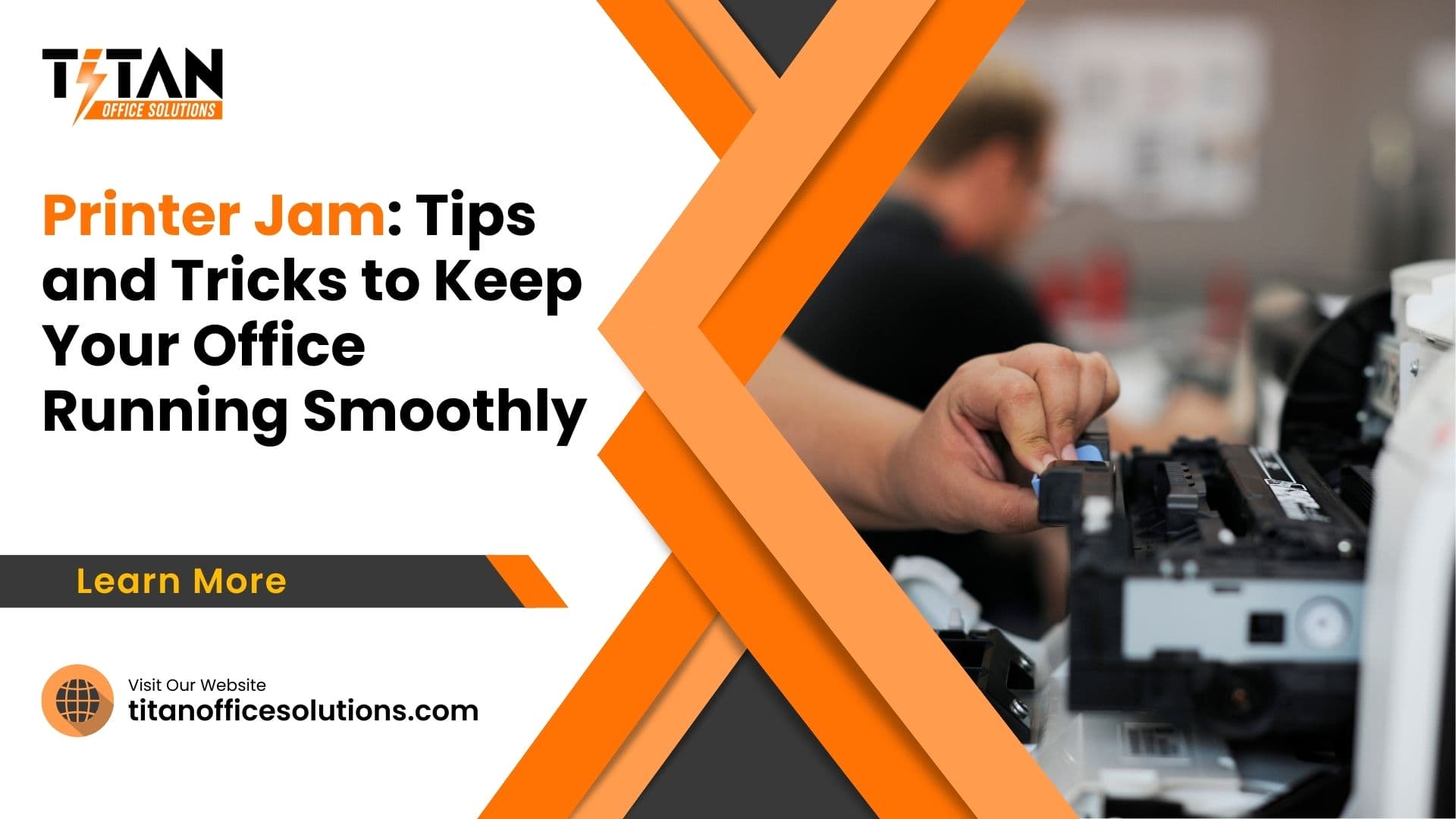Printer jams are a common issues that can significantly disrupt office productivity. When documents are urgently needed, a printer jam can halt the entire workflow, causing delays and frustration. This issue is not just annoying but also impacts the efficiency of an office environment.
Therefore, understanding how to fix a paper jam promptly and effectively is essential for maintaining smooth operations. This guide will explore the causes, solutions, and preventive measures for dealing with printer jams.
What is Printer Jams
Printer jams occur for various reasons, each affecting the printer’s functionality in different ways. The quality of printer paper plays a pivotal role. Low-quality paper can shed fibers or particles that clog the paper feed mechanism, leading to jams. Similarly, improper paper loading in the paper tray can cause sheets to get stuck or misfeed, interrupting the printing process.
There are several types of jams. For instance, a jam could occur inside the printer if a piece of paper becomes lodged in the internal mechanism. Alternatively, paper might get stuck at the entry or exit slot, causing an error. Understanding these variations is crucial for diagnosing and resolving issues efficiently. For more detailed guidance on paper quality and loading techniques, visiting Printer Manufacturer’s Support Page can offer valuable insights.
What causes a printer to jam?
A printer can jam for various reasons, often related to paper and printer maintenance issues. Common causes include using the wrong type of paper, overfilling the paper tray, or loading paper incorrectly, leading to misfeeds and blockages.

Jams can also result from dirt, dust, or debris accumulating on the printer’s rollers or inside its mechanism, hindering paper movement. Moreover, worn-out rollers or parts within the printer can cause paper to become stuck. Ensuring the use of suitable, high-quality paper, proper loading, and regular printer cleaning can help minimize the risk of jams.
How to Fix a Printer Paper Jam
Step-by-Step Guide to Clearing a Jam
- From the Loading Tray: Begin by gently removing any loose sheets from the tray. If the jam persists, carefully extract the stuck paper, ensuring not to tear it. This often solves the immediate problem.
- From the Rear of the Printer: If the jam cannot be accessed from the tray, opening the rear panel might be necessary. This area allows for easier removal of jammed paper that’s not visible or accessible from the front.
- Addressing Jams Under the Front Cover: In some cases, paper may get caught deep within the printer. Carefully opening the front cover and slowly removing the jammed paper can resolve this. However, this approach should be a last resort due to the risk of damaging sensitive printer parts.
- Ensuring the Printer Carriage Can Move Freely: After clearing the jam, check if the printer carriage moves smoothly. This step is vital for preventing future jams and ensuring the printer operates correctly.
Troubleshooting Persistent Jams
Sometimes, a jam may indicate a deeper issue, such as a malfunction in the roller or feed mechanism. In such cases, consulting the manual or seeking professional advice may be necessary. Regular maintenance and cleaning can prevent many of these issues.
Printer jams can be a significant hindrance to office productivity, but with the right knowledge and approach, they can be quickly resolved. Understanding the causes and solutions for printer paper jams is essential for anyone who regularly uses a printer. By following these guidelines, you can ensure your office stays productive and your printer operates smoothly.
How do I clear a paper jam on my HP Deskjet?
To clear a paper jam on your HP Deskjet, first, turn off the printer and unplug it from the power source. Open the rear access door or the paper tray to locate the jammed paper. Gently pull the paper out, making sure not to tear it. If the paper is torn, ensure all pieces are removed to prevent further jams.
Check the rollers and wheels for any remaining debris and remove if found. Close the access doors securely, plug the printer back in, and turn it on. Perform a test print to ensure the issue is resolved. For model-specific instructions, visit HP’s official support website.
How do you fix a carriage jam on a printer?
To fix a carriage jam in a printer, start by turning off your printer and unplugging it. Open the printer cover to access the carriage area. Check for any paper or objects that might be obstructing the carriage’s path and carefully remove them. Move the carriage manually to ensure it can move freely across its entire range of motion. If the carriage is stuck due to dried ink or debris, gently clean the area with a damp, lint-free cloth.

After clearing the obstruction and ensuring the carriage moves smoothly, close the printer cover, plug the printer back in, and turn it on. Perform a test print to confirm the issue is resolved. For specific models, refer to the manufacturer’s instructions for detailed guidance.
Preventing Future Printer Jams
Preventing printer jams is crucial for maintaining efficiency and reducing frustration in the workplace. Proper care and maintenance can significantly decrease the likelihood of jams. Here are some strategies:
- Choose High-Quality Printer Paper: Using the right printer paper is essential. High-quality paper reduces the chance of jams because it has less dust, is more consistent in thickness, and less likely to crumple or tear. This, in turn, helps avoid paper jams in the printer.
- Regular Printer Maintenance: Keeping your printer clean is vital. Dust and paper fiber can accumulate on feed rollers, causing paper to misfeed or jam. Regularly cleaning the parts of the printer that come into contact with paper can prevent these issues. For HP printers, visiting HP Support can provide specific guidance on maintaining your printer model.
- Proper Paper Loading: Carefully re-stack the remaining paper in the paper tray to ensure it’s neatly aligned and not overfilled. Misaligned or overfilled trays are common causes of paper jams. Each printer model may have different tray capacities and paper alignment requirements.
- Adjust Printer Settings: Ensure your printer settings match the paper type and size you’re using. Incorrect settings can lead to jams because the printer may try to feed paper through in a way that’s not suitable for the paper loaded.
- Use the Printer Regularly: Printers left idle for too long may have issues with stiff feed rollers or dry ink that can cause paper to stick or jam. Regular use keeps the mechanics of the printer in good working order.
Advanced Troubleshooting
When basic troubleshooting doesn’t resolve a jam, it may be time to delve deeper:
- Software Issues and Driver Updates: Sometimes, printer jams can be caused by outdated software or drivers. Ensure your printer’s software is up to date by checking the manufacturer’s website. For instance, Canon and HP users can visit their respective support sites for the latest drivers.
- Professional Repair or Replacement: If jams persist despite all efforts, it might indicate a mechanical issue with the printer. Consult with a professional or consider if it’s more cost-effective to replace the printer. Remember, the decision should factor in the age and initial cost of your printer.
What People Also Ask
Why does my printer keep jamming?
Printer jams often occur due to using poor-quality paper, loading paper incorrectly, accumulation of dirt on the feed rollers, or outdated printer software. Ensuring the use of high-quality paper, proper loading, regular cleaning, and software updates can mitigate these issues and improve printer reliability.
How can I fix a paper jam?
To fix a paper jam, you should first turn off and unplug your printer to ensure safety. Then, open the printer access doors to locate and gently remove any visible paper, taking care not to tear it. For specific models, consult the printer’s manual for detailed instructions, as the approach may vary.
What should I do if there’s still paper jammed after I’ve cleared it?
If you’ve removed visible paper and the printer still shows an error, there might be small pieces of paper left behind. Inspect the feed rollers and the path the paper travels through for any debris.
How often should I clean my printer to prevent jams?
Cleaning frequency can depend on usage, but a general rule is to clean the paper feed rollers and check for debris inside the machine every few months.
Conclusion
In conclusion, tackling printer paper jams requires a mix of preventive maintenance and correct handling. Whether it’s a laser printer or an inkjet model, understanding the common causes of paper jams—from dirty feed rollers to improperly loaded paper—is crucial. Remember to unplug the printer before attempting to remove any paper, and consult HP support or Canon guidelines for model-specific advice.
Regularly cleaning your printer and ensuring the paper tray is not overfilled can significantly reduce the risk of jams. Ultimately, knowing how to fix a printer paper jam efficiently can save time and avoid damage to your printer, keeping your office operations smooth and productive. For any persistent issues, don’t hesitate to seek professional help to get your printer back on track.
Titan Office Solutions
Phone: (704) 741-0821
Email: info@titanofficesolutions.com
Hours of Operations: Monday through Friday from 8:30 AM to 6 PM EST.
Website: titanofficesolutions.com

